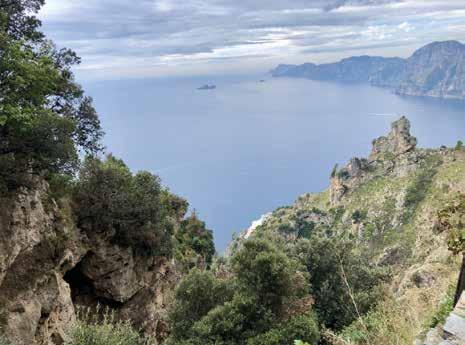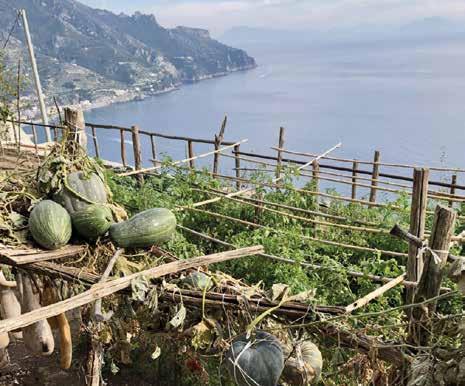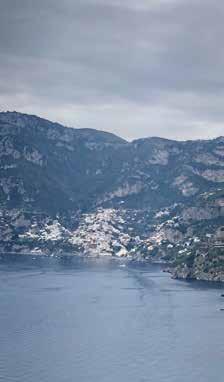
4 minute read
Travel
from American In Britain Winter 2021/22
by American in Britain magazine and The American Hour website
Susan Monshaw Shares Her Recent Visit To Positano, Italy
Italy’s Amalfi coast on the Tyrrhean Sea has so many blessings of nature that the world can’t stay away. Sunny weather, breathtaking views, warm people and the most delicious food, usually sourced just steps from the terrace table where you’re enjoying it. Like so many of the beautiful coastal towns in the region, Positano grew from a tiny fishing village to one of the most popular tourist destinations in Europe.
The most important item to pack for your visit to Positano is comfortable shoes. Most of the central village is accessible only on foot and usually that trek involves many stone stairs, and sloping, cobblestone streets. Hotels, restaurants, and shops are all set into the steep hillside, making for an iconic view of the village, as if a giant spilled his Lego blocks from the top of the cliffs right down to the sea.
Il San Pietro, one of the luxury hotels perched high on the cliff with commanding views of the Gulf of Salerno, is famous for its private rocky beach, daily boat tours for lucky guests, and respect for the natural environment. A shuttle bus takes you to the edge of town (the winding roads being too dangerous to walk) where you are on foot from there. It’s possible to take day trips to the ancient excavated Roman cities of Pompeii or Herculaneum, hike to the top of legendary Mount Vesuvius (Europe’s only active volcano), or ride the ferry to the famously chic island of Capri.
For something a little different than the usual touristic fare, there is a hike along the Path of the Gods, and a lesson in southern Italian cuisine at Mamma Agata’s hidden kitchen in nearby Ravello.
Atmospheric is the only way to describe this truly hidden gem of a cookery school. Descend the stairs from the alleyway entrance and you are assaulted by a sensory overload. Before you, lies a vast view of the sparkling, blue sea, made even wider from this vantage point 1,000 feet above sea level. Terraced gardens march away below, featuring lemon and olive trees, grapevines, miles of tomatoes and all manner of vegetables. The scents of salty air, freshly cut grass and enticing aromas from the kitchen make your belly rumble. There is a huge terrace table, set with wine glasses and distinctive, locally handpainted dishes. Beyond that is a grassy area with lounge chairs, a small patio and a huge pizza oven. The sound of a cock crowing and church bells in the distance compete with our hostess Chiara Lima’s invitation and broad smile, “I hope you’re hungry”.
What follows is six hours of bliss. Chiara, the youngest daughter of Mamma Agata and the fifth generation to cook and farm on the property, demonstrates how to make the perfect meatballs and eggplant parmigiana. She puts together a simple yet unforgettable tomato sauce for the Farmer’s




Spaghetti she creates with pasta made from her own durum wheat. “Piano, piano”, she exhorts the group of eager students. “Slowly, slowly”, she says, referring to both the sizzling garlic and simmering ragu.
A day at the first cookery school on the Amalfi coast begins with an “Italian breakfast” consisting of a huge cappuccino and a slice of perfect lemon cake. Made with type 00 flour, the cake is dense and not too sweet. Students come away with recipes, tips and big plans to recreate these dishes at home.
A great way to combat all those lovely calories is to hike the Path of the Gods. So named in Homer’s tale of the Odyssey, where the path is said to have been created by the gods rushing to save Ulysses from the singing Sirens of Capri. The name can also refer to the magnificent, top-of-theworld views along the 8 km trail which people have been walking for centuries.
While it can be physically breathtaking to reach the summit, the worthwhile vistas are truly breathtaking. For the seasoned and hardy, you can start your trek in Praiano, requiring a near vertical climb up a series of stone steps through a charming neighbourhood with tiered gardens, leading to the trailhead. From there, the trail is mostly stairs with wooden handrails, necessary to steady yourself as you stop to take in the grand views of the shimmering sea and craggy cliffs. Along the way, you’ll spy elements of a local art installation featuring sculptures and painted ceramic tiles. Halfway to the summit, there is a gorgeous medieval chapel with well preserved frescoes inside.
Further up the hillside, farmers were harvesting olives while their small terrier stood guard. Terraced farms are set directly into the hillside, caves often serving as home to goats or people. Another, easier, access to the Path begins in Bomerano. This way allows walkers to visit a picturesque convent and even grab a bite and a drink at a small café. Either way, the trail ends at Positano where a well-deserved pizza and glass of Tuscan red rewards weary hikers at the beach front restaurant Le Tre Sorelle.
It is best to visit this region of Italy, the entire coast was named a Unesco World Heritage Site in 1997, during the warmer months. While the weather is mild throughout winter, many hotels and restaurants take a hiatus, closing at the end of October and re-opening in early spring.












